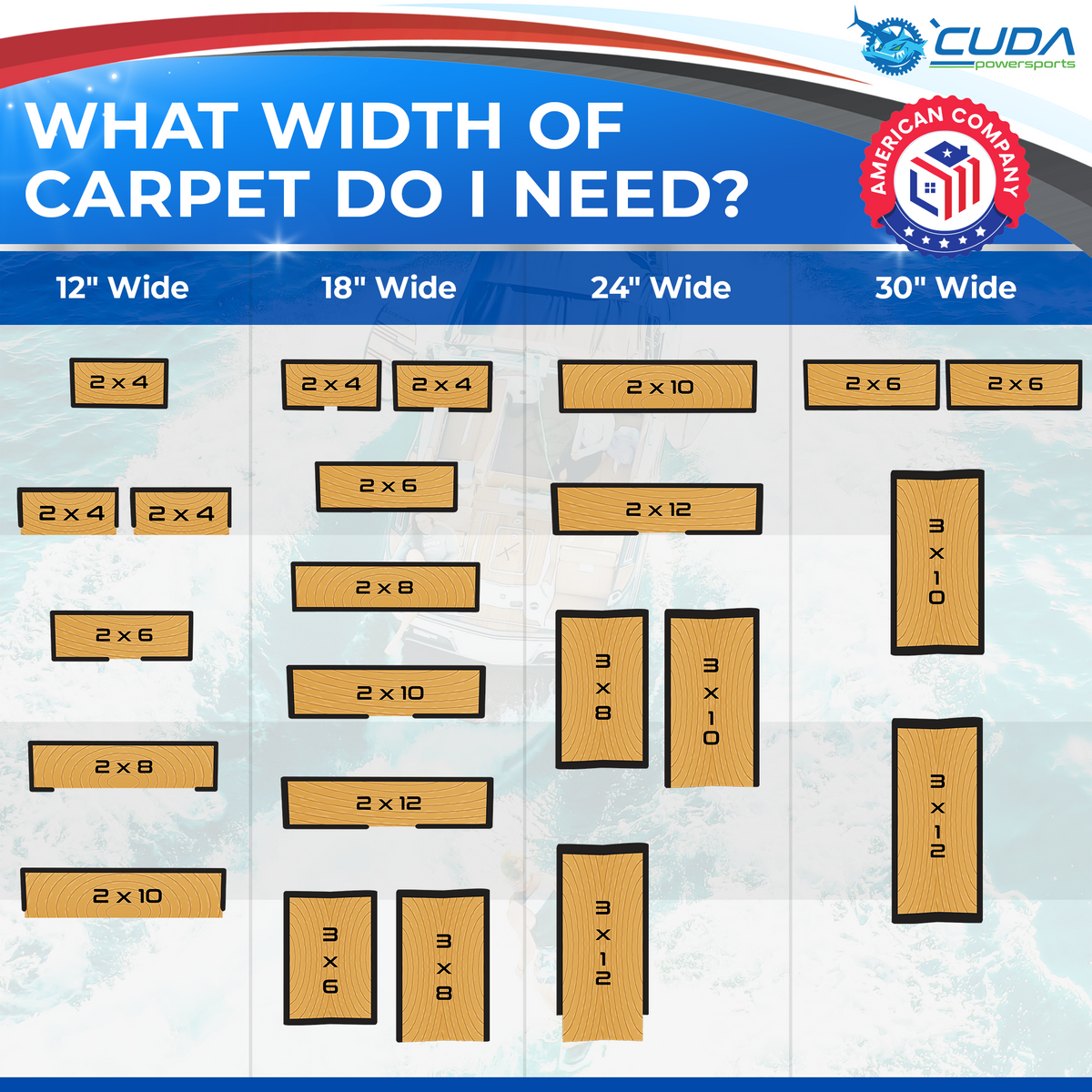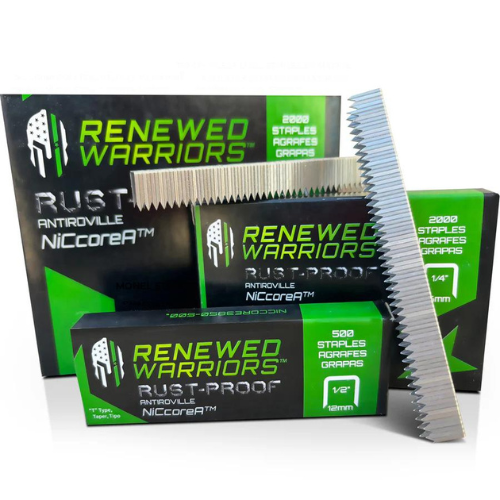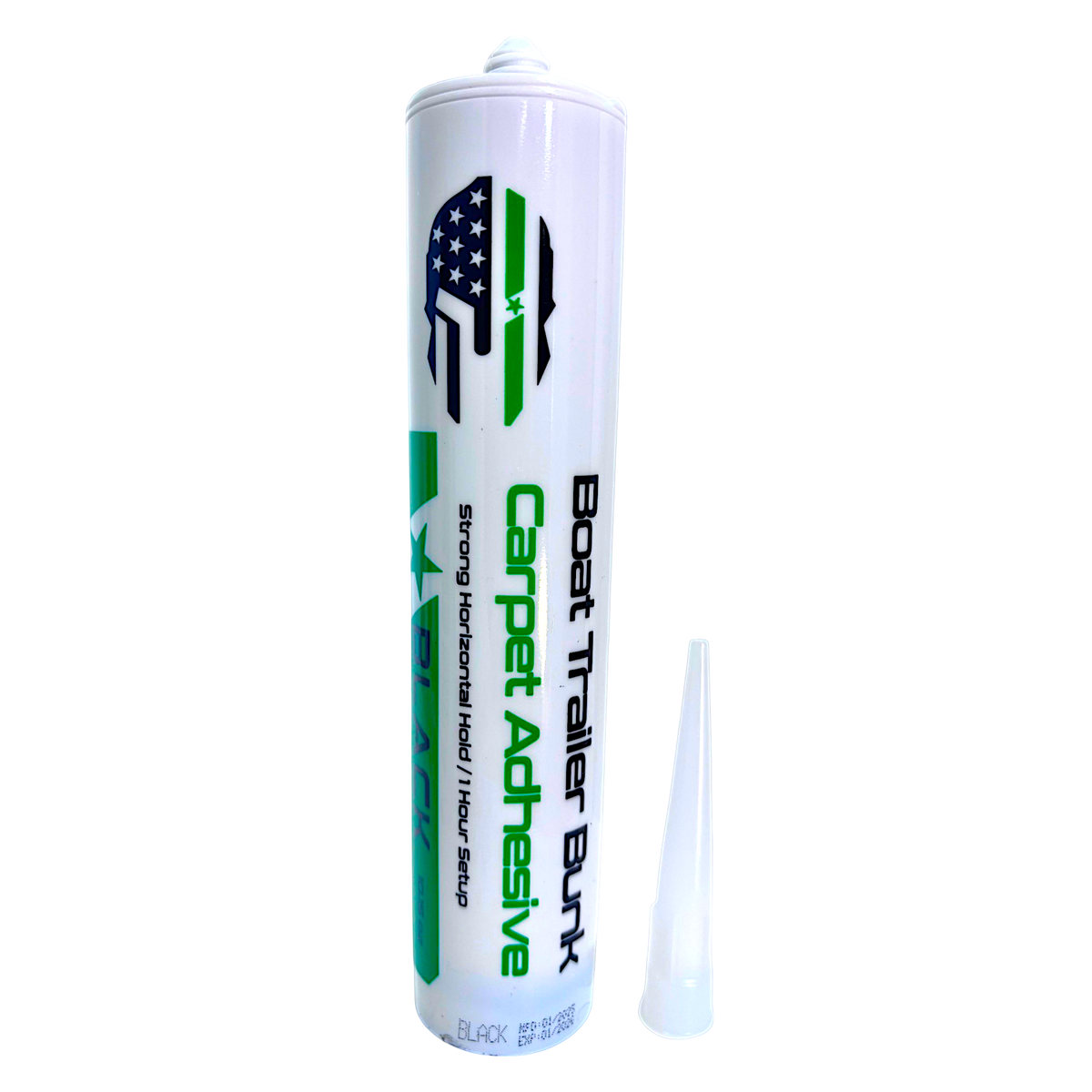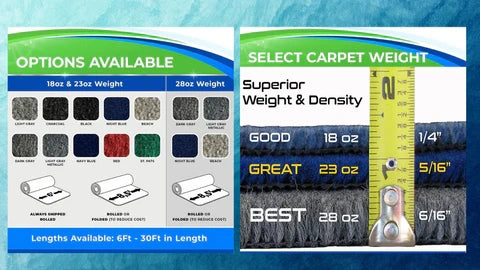Disclaimer
Content from Cuda Powersports is for educational purposes only and may not reflect your specific conditions. Always read and follow the original manufacturer’s instructions and applicable regulations. Proceed at your own risk. Cuda Powersports makes no guarantees of results and assumes no responsibility for injuries, property damage, or costs related to any implementation. By using any recommendation from Cuda Powersports, you agree to use it at your sole risk, to indemnify and hold harmless Cuda Powersports, its members, employees, and affiliates from and against claims, losses, or expenses (including reasonable attorneys’ fees) arising from your implementation, except to the extent prohibited by law.
.
Boat Trailer Bunk Carpeting
What Width of Carpet Do I Need To Wrap My Boat Trailer Bunk Boards?
The most common types of bunk boards are 2”x4” and 2”x6”. For 2”x4” bunk boards we recommend our 9” wide bunk carpet, 12" wide carpet can be used if you wish to wrap even the bottom of the bunk board as well, this is purely an aesthetics choice. For 2”x6” bunk boards we recommend 12” wide. Both of these widths (9" for 2"x4" and 12" for 2"x6") will leave roughly a 1.5” gap at the bottom of your bunk board to allow water to escape both your board and your carpet – ensuring your boards will last longer and not rot as quickly.
Can you fully wrap your bunk boards for aesthetics or looks? Sure! Just know that water may become trapped in the boards longer and potentially shorten their life due to premature rotting. Side Bunk, or Guide Bunks, typically come fully wrapped because they spend little to no time in the water due to their location higher up on the trailer. Also know that if you
purchase prewrapped bunk boards they will likely come fully wrapped and without adhesive because trailer builders use a jig when building boards and it doesn’t lend itself to boards that are not fully wrapped. For all other bunk board sizes please see the chart below to better understand what size of carpet will fit which width of board.

How Much Bunk Carpet Do I Need? What’s the Length of Bunk Carpet I Need?
A good rule of thumb is to measure each bunk board and then add an additional foot, or 12 inches, to the length of your bunk board. This is the amount of carpet you need to allow for 6 inches of carpet on the end of each board to wrap each end and secure underneath the board. While 6 inches is recommended you can get away with a minimum of 3” on each end to wrap the end and secure the carpet underneath. Then add up all the carpet you need and place your order. Please review the image below if you still have any questions.

What is the Difference Between Your Premium & FOREVER Bunk Carpeting?
Outside of the obvious weight difference, the Premium Carpet is softer, more plush and has a life expectancy of 10+ years when correctly used. Our Premium carpet is 100% water permeable and recommended for boats having a DRY WEIGHT of 4,000lbs or less with occasional use, occasional salt or brackish water is acceptable. The FOREVER Carpet is slightly less plush than our Premium but has a much stronger patent pending backing that is stretch/tear resistant, it won't be as plush but will be stronger and should last longer. The FOREVER carpet has slightly stronger UV inhibitors, shielding it longer from harmful UV rays and color fading. The FOREVER Carpet is also water permeable and recommended for boats having a DRY WEIGHT of over 4,000lbs. We recommend our FOREVER carpet for boats that will be used in salt or brackish waters. Both carpets will do great when it comes to protecting your boat. If you're worried about the FOREVER carpet being less pliable simply let it sit in the sun unrolled for 5-10 minutes before applying it to your bunk board and it will be very easy to work with.
What Weight of Boat Trailer Bunk Carpet Should I Choose?
This depends more on your boat's weight and frequency of use. Bunk Trailer Carpet is typically sold in numerous weight options. These are recommendations only, not hard-fast rules, and vary depending on use, abuse, etc.
*12oz-16oz weight typically only recommended for small PWC (jetskis/waverunners), jon boats, kayaks. If you use these frequently we recommend a heavier weight carpet..
*17oz-20oz weight for lighter weight boats having a DRY WEIGHT of 2,000lbs or less, freshwater only, average use. If use is semi-frequent then we recommend a heavier weight carpet.
*20oz-30oz weight for watercraft having a DRY WEIGHT of 4,000lbs or less with occasional use, occasional salt or brackish water is acceptable. If use is semi-frequent then we recommend a heavier weight carpet.
*32oz-38oz weight (FOREVER Carpet) for watercraft having a DRY WEIGHT between 4,000lbs - 8,000lbs. FOREVER Carpet can accommodate watercraft in excess of 8,000lbs but Cuda's Hot Spot Patch should be incorporated and installed atop FOREVER Carpet on areas of the bunk board that show wear easily or areas of the bunk board where the carpet previously failed prematurely. As Holds up well to salt and brackish water and watercraft that are used very frequently.
*Cuda's ~60oz Patent Pending Hot Spot Patch is made of heavy polyester carpet, in the shape of a butterfly bandage that incorporates a new innovative PVC backing - having an equivalent weight of approximately 60oz psy. Our patches are used as temporary patches to get your boat in/out of the water when your bunk carpet unexpectedly fails and for use with heavy boats, and on areas of bunk boards that are prone to have the carpet fail prematurely.
*Cuda's Super Slides, made of our proprietary EthylGlide 80 Compound. If you're sick of carpet, check these out. Due to their extreme density they handle boats of any size/weight and provide a smooth friction resistant loading/unloading experience.
Is The FOREVER Carpet Pliable and Easy to Fold?
Yes, the FOREVER Carpet has a unique backing not found on other bunk carpeting products but the carpet still remains pliable. If you find the carpet to be slightly too stiff when assembling your boards we recommend you let the carpet sit in the sun first for 10 minutes with the backing facing up towards the sun. This will heat the backing up and make it much more pliable.
What Size Staples Do I Need For My Bunk Boards?
We recommend staples having a 3/8" width crown or T50 Type Staples, and staples that have a 1/2" leg so the staple is able to penetrate through Cuda's thicker carpet and drive into the board.
We've found the best performing staples for bunk boards to be from Renewed Warriors. They have staples available in Stainless Steel, or their Rustproof NiCcoreA alloy for harsher environments. Both types are available in 3/8" width crown and 1/2" leg which can be used in most all Manual DIY staple guns.

Does Bunk Carpet for Bunk Boards Require Adhesive When Recarpeting?
It is not required, but it is highly recommended. Bunk Board Carpet goes under tremendous stress when loading/unloading your boat. Carpet that bunches or stretches and pulls on the sharp corners and edges of bunk boards lead to your carpet weakening and tearing prematurely. Adhering your carpet to the board prevents your carpet from stretching or bunching, resulting in your boat being loaded/unloaded slightly easier and extends the life of your bunk carpet. Note: It IS a requirement of Cuda Powersports unmatched bunk carpet warranty that adhesive and staples are purchased through Cuda Powersports in order to receive the benefits of our 10Yr & 20Yr warranty period.
Where Do I Apply Bunk Carpet Adhesive
Apply adhesive to the top or "Face" of board, not recommended you apply to sides or back of board as this will only cause a mess. Renewed Warriors adhesive, supplied in a tube, does not require a trowel for application - simply apply using 1/8" - 3/16" bead. If you're using an adhesive that does require a trowel use the 1/8" notch.
What Type of Adhesive Should I Use on Bunk Boards and Bunk Carpeting?
At Cuda Powersports we have found that Roberts 6700 Outdoor Carpet Adhesive has performed pretty well over the years for outdoor use on covered patios and with marine carpet.
Recently, a company by the name of Renewed Warriors has come up with a new bunk carpet adhesive that is specifically made to adhere carpeting to bunk boards that store boats and PWC off the water and for long-term storage. This new product dries very quikcly while Roberts 6700 takes 24-48 hours to cure or more according to their website. Renewed Warriors Bunk Carpet Adhesive comes in a large tube that you apply using a caulking gun and you don't need a trowel to apply it - making it much easier to use than Roberts 6700. We have also found the Renewed Warriors product will still adhere to painted or surfaces where sealant has been applied.
We're currently testing this new product but the results have been great so far. We hope to begin selling this new Renewed Warriors Bunk Carpet Adhesive in the later part of 2025.

Do I Need to Cut a 45 Degree Angle in My Bunk Boards?
No, we highly discourage people from cutting their bunk boards at an angle and then wrapping them with carpet. Your boat's hull should never come in contact with the leading edge of your bunk board - if it does your not putting your boat trailer far enough in the water. Cutting your Bunk Boards at a 45 degree angle only makes a sharper edge at the back of your bunk board which will result in your carpet tearing prematurely on that sharp angle. Just round all edges of your bunk boards to remove any sharp or leading edges.
Should I Sand, Router, or Take The Edges off My Bunk Boards
Yes, simply running a sanding block, palm sander or something across the sharp edges or ends of a bunk board can result in your carpeting lasting much longer. Lumber can have sharp edges, ends, or corners, and at Cuda Powersports we've found that quickly sanding down the sharp edges so they're more rounded can result in bunk carpeting lasting much longer as the carpet is less prone to tearing on those sharp edges.
What is The Best Kind of Bunk Carpet Material?
Solution-dyed polypropylene (olefin) used to be the predominant type of bunk carpet material, BUT THIS IS NO LONGER THE CASE, this type of carpet you typically see on bass boats and pontoon carpet having the rubber backing. Olefin type carpet has a rubber backing and lead to bunk boards rotting prematurely and the hardware failing.
The industry has since changed and the Best Kind of Bunk Carpet is rPET (recycled polyethylene terephthalate) or PET type (polyethylene terephthalate). This material is available through 'Cuda, is strong, durable, has strong UV Inhibitors, and dries out quickly which allows the bunk boards and hardware to last longer.
Can I Use Pressure Treated Wood for my Bunk Boards?
That depends on whether or not your trailer, brackets, or boat hull is made of aluminum. If so, we strongly encourage you NOT to use pressure treated wood as Copper-based treatments can lead to quickly occurring electrolysis and accelerate corrosion on aluminum. Instead source good strong native lumber from your area of the USA and apply a sealer or apply a high quality exterior house paint in satin or eggshell. When in doubt of the type of lumber to use Douglas Fir performs rather well we've found.
How Should I Seal My Bunk Boards? What Type of Bunk Board Sealer Should I Use?
Any type of sealant is better than no sealant at all. Olympic, Thompsons, all work well. Some people try to sell a high dollar Marine Sealant and we've found minor, if any, increases in performance.
We recommend NOT using fiberglass resin, despite what a popular Youtuber stated years ago and has gone viral by other Youtube influencers. Fiberglass resin, is nasty and difficult to work with, a terrible carcinogen. The biggest reason is based on performance - have you ever worked with fiberglass resin?? Its dries extremely hard and is NOT intended to flex. What do bunk boards do? They flex like crazy during loading/unloading/trailering, etc. they are constantly flexing. Fiberglass resin will dry extremely hard, become brittle, and then fracture and fail over a very short time. Leading to constant water infiltration.
Our favorite sealer is actually a high quality acrylic exterior house paint in eggshell or satin so adhesive can still easily adhere to the wood - semi gloss or gloss is not recommended. Also, don't paint or seal the bottom of the board. Water is going to get in to that board no matter how had you try to prevent it, so give it an easy way to get out of the lumber. Leaving the bottom of the bunk board unsealed allows your board to dry out and last considerably longer.
How Do I Clean and Maintain Bunk Carpet?
Simply hose or rinse off when the boat is not on the trailer. Using lubricants on the bunk boards will also attract dirt and gravel.
Can I Use Carpet with Bunk Super Slides Atop?
No, do not. Carpet naturally compresses, but the counter sunk threaded screws you use to attach the slides will not compress. Once the boat is loaded its weight will sit upon the slides, compressing any carpet found underneath. However, the screws will not compress and if there is carpet under the Super Slides then you risk a screw head popping up and scratching your hull.
What is Your Warranty For Bunk Carpeting
Please see the Warranty Section of our website for details, found here.
What Type of Mounting Hardware Should I Use on Bunk Boards?
We always recommend that you replace with like hardware originally supplied by your trailer manufacturer.
Typically, carriage bolts that are countersunk into the boards, with large flat washers and nuts on the underside of the board hold the best. Lag bolts also work well, are less expensive but can loosen over time. We always recommend drilling a pilot hole when using lag bolts.
As far as finish, zinc/galvanized work well for most applications. In salt/brackish environments you should consider Stainless Steel or NiCcoreA.
How Tight Should the Carpet Be Wrapped?
Typically, you want to wrap carpet as tightly as possible and ensure it comes in good contact with any adhesive, if being used. Loose carpet, contributes to carpet bunching during loading/unloading which then results in tearing/ripping. Wrap it tight, but don't go crazy :)
Bunk Boards
What are bunk boards and what do they do?
Bunk boards support and guide your boat during loading, unloading, and transport.
They distribute hull weight, stabilize the boat, and protect the gelcoat when
properly carpeted or fitted with low-friction 'Cuda Super Slides.
What Wood to Use For Trailer Bunks
That depends on whether or not your trailer, brackets, or boat hull is made of aluminum. If so, we strongly encourage you NOT to use pressure treated wood as Copper-based treatments can lead to quickly occurring electrolysis and accelerate corrosion on aluminum. Instead source good strong native lumber from your area of the USA and apply a sealer or apply a high quality exterior house paint in satin or eggshell. When in doubt of the type of lumber to use Douglas Fir performs rather well we've found.
Whats The Longest Bunk Board You Ship?
We ship boards up to 104" in length. Boards over this size must be shipped freight at a cost of roughly $500-600 a pair. If you are willing to pick-up our bunk boards in either Colorado or Georgia you may contact us for a quote to pick up your boards at one of our Colorado or Georgia locations between Monday - Friday.
Can I Use Pressure Treated Wood for my Bunk Boards?
That depends on whether or not your trailer, brackets, or boat hull is made of aluminum. If so, we strongly encourage you NOT to use pressure treated wood as Copper-based treatments can lead to quickly occurring electrolysis and accelerate corrosion on aluminum. Instead source good strong native lumber from your area of the USA and apply a sealer or apply a high quality exterior house paint in satin or eggshell. When in doubt of the type of lumber to use Douglas Fir performs rather well we've found.
Should I choose wood or composite bunk boards?
Up to you, as there are pros/cons with either. Pressure-treated lumber is cost-effective and easy to source but should not be used anywhere around aluminum. Douglas Fir is a well performing alternative, found throughout the US, but should be sealed or painted for longetivity; composites resist rot, warping,
and water absorption, and typically last much longer. Composites can be
slightly heavier and requires pre-drilling for fasteners to prevent splitting.
How Should I Seal My Bunk Boards? What Type of Bunk Board Sealer Should I Use?
Any type of sealant is better than no sealant at all. Olympic, Thompsons, all work well. Some people try to sell a high dollar Marine Sealant and we've found minor, if any, increases in performance.
We recommend NOT using fiberglass resin, despite what a popular Youtuber stated years ago and has gone viral by other Youtube influencers. Fiberglass resin, is nasty and difficult to work with, a terrible carcinogen. The biggest reason is based on performance - have you ever worked with fiberglass resin?? Its dries extremely hard and is NOT intended to flex. What do bunk boards do? They flex like crazy during loading/unloading/trailering, etc. they are constantly flexing. Fiberglass resin will dry extremely hard, become brittle, and then fracture and fail over a very short time. Leading to constant water infiltration.
Our favorite sealer is actually a high quality acrylic exterior house paint in eggshell or satin so adhesive can still easily adhere to the wood - semi gloss or gloss is not recommended. Also, don't paint or seal the bottom of the board. Water is going to get in to that board no matter how had you try to prevent it, so give it an easy way to get out of the lumber. Leaving the bottom of the bunk board unsealed allows your board to dry out and last considerably longer.
What Type of Mounting Hardware Should I Use on Bunk Boards?
We always recommend that you replace with like hardware originally supplied by your trailer manufacturer.
Typically, carriage bolts that are countersunk into the boards, with large flat washers and nuts on the underside of the board hold the best. Lag bolts also work well, are less expensive but can loosen over time. We always recommend drilling a pilot hole when using lag bolts.
As far as finish, zinc/galvanized work well for most applications. In salt/brackish environments you should consider Stainless Steel or NiCcoreA.
What is Your Warranty For Boat Trailer Bunk Boards?
Please see the Warranty Section of our website for details, found here.
Any Installation Tips for First-Timers?
Use previous bunk boards as a template. Dry-fit on the trailer first, mark hardware locations, and pre-drill. Staple carpet
from the center outward, keep fasteners off the top face, and re-check bracket
torque after the first few trips.
Are Cuda Bunk Materials Safe for Saltwater Use?
Yes—as well as one can reasonably expect - salt water is nasty on just about everything. Rinse after each salt trip. Use stainless hardware, sealed wood or composite boards, and marine-grade carpet or slide materials designed for UV and salt resistance.
What’s the Correct Bunk Height and Angle?
Always use the original specifications that came with your trailer as new from the manufacturer. The following is best practice if you're building a custom trailer: Bunks should cradle the hull evenly with the keel centered; height must clear fenders while allowing proper ramp depth. Adjust pivot brackets so the full bunk face
contacts the hull—no sharp pressure points.
Replacement Boat Carpet or Pontoon Carpet
Boat Carpet is Offered as Folded or Rolled, What's the Difference?
Rolls of carpet are either 6Ft or 8.5Ft in width - it's very expensive to ship a package of that width. Because of this it appears every other competitor of ours has opted to only offer folded carpet to save money. Every shipping carrier (UPS, FedEx, Etc.) has oversize dimensions that begin at 48" or more on any one side. So folding the carpet saves considerably when it comes to shipping cost.
So what is the downfall of folding boat carpet? Ever unpacked a brand new button down shirt that was tightly folded and wrapped in packaging? It has significant folds in it that typically cannot be removed without going through the washing machine and then ironed - same applies to carpet. Folding the carpet saves considerable money on shipping but will require you stretch the carpet for a number of days in direct sunlight, and sometimes moisten the carpet and allow it to dry multiple times before installing. Otherwise, the fold lines will appear in the carpet after its installed on your boat.
'Cuda is proud to offer a rolled carpet option as well that is more expensive to ship, but will result in a carpet that does NOT have fold marks, will not require such effort to remove the folds, and can be immediately installed. The choice is up to you.
What type of carpet is best for bass and pontoon boats?
Solution-dyed polypropylene (olefin) marine carpet is the standard—it’s UV stable, mildew-resistant, fast-drying, and stands up to fish slime and sunscreen better than nylon or residential polyester.
What face weight and thickness should I choose?
Common marine face weights range 16–28 oz/yd² (approx. ¼"–⅜" pile). Heavier face weight feels plusher and hides seams better; lighter weights dry faster and are easier to wrap around tight radii.

What roll widths are available?
Typical widths are 6 ft and ~8.5 ft (pontoon deck width). Measure your largest span to minimize seams.
Is the carpet truly waterproof?
The fibers are hydrophobic and the backing is water-resistant, but deck drainage still matters. Proper adhesive coverage, sealed edges, and open limber holes prevent water trapping and mildew.
What are the ideal install conditions and cure times for boat carpeting
Install between 60–90°F with low to moderate humidity. Light set in 2–4 hours, workable open time ~20–40 minutes, full cure 24–72 hours before heavy use (longer in cool/damp conditions).
Which adhesive should I use on wood vs. aluminumdecks?
On sealed plywood: a marine/outdoor carpet adhesive (water-based) applied with a notched trowel. Some water-based adhesives also work on aluminum as well as it if roughed up beforehand to promote adhesion. On aluminum: a solvent-based marine adhesive or contact cement recommended by the adhesive maker for non-porous metal.
What trowel notch size is recommended?
Common specs: 1/8" x 1/8" V-notch (or 3/32" V-notch for lighter carpets). Follow the adhesive’s spread-rate guidance; you want full transfer without puddling.
How do I prep the boat deck before gluing down carpet?
Remove old carpet/adhesive, scrape smooth, sand high spots, vacuum dust, clean with solvent appropriate to the substrate, repair soft wood, and seal raw plywood edges/end grain.
Should I carpet first or build hatch lids first?
Pre-fit lids, then carpet the deck and lids separately for clean reveals. Wrap carpet
under lid edges and around radii; test fit hardware holes after cure.
How do I wrap corners and tight radii without bulk?
Make small relief cuts on the underside, stretch evenly, and use stainless staples
on hidden faces (stringer side). Warm the backing slightly if needed to
increase flexibility.
How do I handle boat carpet seams
Plan seams under consoles or along straight, low-traffic runs. Dry-fit, cut with a sharp knife using a straightedge, and butt seams—don’t overlap. Roll seams
firmly into wet adhesive.
What tolerances should I expect for weight, density, and size?
Because marine carpet is tufted from extruded fibers (denier can vary slightly), set to stitch rate and pile height with normal machine tolerances, then backed and cured (moisture loss changes mass/loft), minor differences are inherent. Please allow up to ±5% variation in listed face weight (oz/yd²) and ±1–2% (or up to
±0.25") in finished cut size due to manufacturing and machining processes.
Does pile direction matter?
Yes—keep the nap running the same direction across all panels to avoid shading differences. Mark arrows on the backing before cutting. Carpet color can look different depending on which way the carpet is laying.
How do I clean and maintain the new carpet?
Rinse after trips, especially saltwater. Use mild boat soap, soft brush, and fresh
water. Avoid bleach/solvents; lift hatches to air-dry. Periodically vacuum to remove grit that abrades fibers.
Can I install carpet over vinyl or old adhesive?
Best practice is to strip to a clean, sound surface. Gluing over vinyl or thick, uneven residue risks telegraphing, weak bond, and trapped moisture.
Do you Offer Samples
Yes, and we highly recommend you purchase a 2"x2" sample prior to purchasing to ensure color matching. Please note: that samples are for color matching only - in most cases our 18oz carpet will be used as samples so it may not be representative of the weight, thickness, and density of your desired carpet.

